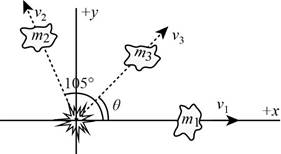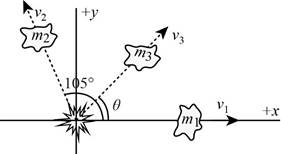
A space probe, initially at rest, undergoes an internal mechanical malfunction and breaks into three pieces. One piece of mass ml = 48.0 kg travels in the positive x-direction at 12.0 m/s, and a second piece of mass m2 = 62.0 kg travels in the xy-plane at an angle of 105° at 15.0 m/s. The third piece has mass m3 = 112 kg. (a) Sketch a diagram of the situation, labeling the different masses and their velocities, (b) Write the general expression for conservation of momentum in the x- and y-directions in terms of m1, m2, m3, v1, v2 and v3 and the sines and cosines of the angles, taking θ to be the unknown angle, (c) Calculate the final x-components of the momenta of m1 and m2. (d) Calculate the final y-components of the momenta of m1 and m2. (e) Substitute the known momentum components into the general equations of momentum for the x- and y-directions, along with the known mass m3. (f) Solve the two momentum equations for v3 cos θ and v3 sin θ, respectively, and use the identity cos2 θ + sin2 θ = 1 to obtain v3. (g) Divide the equation for v3 sin θ by that for v3 cos θ to obtain tan θ, then obtain the angle by taking the inverse tangent of both sides, (h) In general, would three such pieces necessarily have to move in the same plane? Why?
a)
Answer to Problem 46P

Explanation of Solution
The diagram of the breakage is,

The numerical values of the masses and velocities are,
The numerical values of the masses and velocities are,
Conclusion:
Thus, the diagram of the breakage is,

(b)
Answer to Problem 46P
Explanation of Solution
The general expression for the conservation of momentum in x-direction is,
The general expression for the conservation of momentum in y-direction is,
Conclusion:
Thus, the general expression for the conservation of momentum in x-direction is
(c)
Answer to Problem 46P
Explanation of Solution
The final x-component of the momenta of the mass
Substitute
The final x-component of the momenta of the mass
Substitute
Conclusion:
Thus, the final x-component of the momenta of the mass
(d)
Answer to Problem 46P
Explanation of Solution
The final y-component of the momenta of the mass
Substitute
The final y-component of the momenta of the mass
Substitute
Conclusion:
Thus, the final y-component of the momenta of the mass
(e)
Answer to Problem 46P
Explanation of Solution
The final x-component of the momenta of mass
The final y-component of the momenta of mass
Conclusion:
Thus, the final x and y-components of the momenta of mass
(f)
Answer to Problem 46P
Explanation of Solution
In the x-direction,
In the y-direction,
Squaring and adding the equations,
Conclusion:
Thus, the velocity
(g)
Answer to Problem 46P
Explanation of Solution
The tangent of the angle is,
Thus, the angle is,
The angle must be in third quadrant. So, angle
Conclusion:
Thus, the angle
(h)
Answer to Problem 46P
Explanation of Solution
The momentum of the third fragment must be equal in magnitude and must be in the opposite direction to the resultant of the other two fragments momenta. So, all three pieces have to move in the same plane.
Conclusion:
Thus, all three pieces have to move in the same plane.
Want to see more full solutions like this?
Chapter 6 Solutions
College Physics
Additional Science Textbook Solutions
Fundamentals Of Physics - Volume 1 Only
Essential University Physics (3rd Edition)
College Physics
EBK FUNDAMENTALS OF THERMODYNAMICS, ENH
Glencoe Physics: Principles and Problems, Student Edition
Physical Universe
- A cannon is rigidly attached to a carriage, which can move along horizontal rails but is connected to a post by a large spring, initially unstretchcd and with force constant k = 2.00 104 N/m, as shown in Figure P8.60. The cannon fires a 200-kg projectile at a velocity of 125 m/s directed 45.0 above the horizontal. (a) Assuming that the mass of the cannon and its carriage is 5 000 kg, find the recoil speed of the cannon. (b) Determine the maximum extension of the spring. (c) Find the maximum force the spring exerts on the carriage. (d) Consider the system consisting of the cannon, carriage, and projectile. Is the momentum of this system conserved during the firing? Why or why not?arrow_forwardA rocket has total mass Mi = 360 kg, including Mfuel = 330 kg of fuel and oxidizer. In interstellar space, it starts from rest at the position x = 0, turns on its engine at time t = 0, and puts out exhaust with relative speed ve = 1 500 m/s at the constant rate k = 2.50 kg/s. The fuel will last for a burn time of Tb = Mfuel/k = 330 kg/(2.5 kg/s) = 132 s. (a) Show that during the burn the velocity of the rocket as a function of time is given by v(t)=veln(1ktMi) (b) Make a graph of the velocity of the rocket as a function of time for times running from 0 to 132 s. (c) Show that the acceleration of the rocket is a(t)=kveMikt (d) Graph the acceleration as a function of time. (c) Show that the position of the rocket is x(t)=ve(Mikt)ln(1ktMi)+vet (f) Graph the position during the burn as a function of time.arrow_forwardFrom what might be a possible scene in the comic book The X-Men, the Juggernaut (mJ) is charging into Colossus (mC) and the two collide. The initial speed of the Juggernaut is vJi and the initial speed of Colossus is vCi. After the collision, the final speed of the Juggernaut is vJf and the final speed of Colossus is vCf as they each bounce off of the other, heading in opposite directions. a. What is the impulse experienced by the Juggernaut? b. What is the impulse experienced by Colossus? c. In your own words, explain how these impulses must compare with each other and how they are related to the average force each superhero experiences during the collision.arrow_forward
- A projectile of mass 2.0 kg is fired in the air at an angle of 40.0 to the horizon at a speed of 50.0 m/s. At the highest point in its flight, the projectile breaks into three parts of mass 1.0 kg, 0.7 kg, and 0.3 kg. The 1.0-kg part falls straight down after breakup with an initial speed of 10.0 m/s, the 0.7-kg part moves in the original forward direction, and the 0.3-kg part goes straight up. Launch a. Find the speeds of the 0.3-kg and 0.7-kg pieces immediately after the break-up. b. How high from the break-up point does the 0.3-kg piece go before coming to rest? c. Where does the 0.7-kg piece land relative to where it was fired from?arrow_forwardA girl of mass mg is standing on a plank of mass mp. Both are originally at rest on a frozen lake that constitutes a frictionless, flat surface. The girl begins to walk along the plank at a constant velocity vgp to the right relative to the plank. (The subscript gp denotes the girl relative to plank.) (a) What is the velocity vpi of the plank relative to the surface of the ice? (b) What is the girls velocity vgi relative to the ice surface?arrow_forwardInitially, ball 1 rests on an incline of height h, and ball 2 rests on an incline of height h/2 as shown in Figure P11.40. They are released from rest simultaneously and collide elastically in the trough of the track. If m2 = 4 m1, m1 = 0.045 kg, and h = 0.65 m, what is the velocity of each ball after the collision?arrow_forward
- What exhaust speed is required to accelerate a rocket in deep space from 800 m/s to 1000 m/s in 5.0 s if the total rocket mass is 1200 kg and the rocket only has 50 kg of fuel left?arrow_forwardTwo bumper cars at the county fair are sliding toward one another (Fig. P11.54). Initially, bumper car 1 is traveling to the east at 5.62 m/s, and bumper car 2 is traveling 60.0 south of west at 10.00 m/s. They collide and stick together, as the driver of one car reaches out and grabs hold of the other driver. The two bumper cars move off together after the collision, and friction is negligible between the cars and the ground. a. If the masses of bumper cars 1 and 2 are 596 kg and 625 kg respectively, what is the velocity of the bumper cars immediately after the collision? b. What is the kinetic energy lost in the collision? c. Compare your answers to part (b) from this and Problem 54. Is one answer larger than the other? Discuss and explain any differences you find.arrow_forwardA vessel at rest at the origin of an xy coordinate system explodes into three pieces. Just after the explosion, one piece, of mass m, moves with velocity (-30 m/s) and a second piece, also of mass m, moves with velocity (-30 m/s) . The third piece has mass 3m. Just after the explosion, what are the (a) magnitude and (b) direction of the velocity of the third piece?arrow_forward
 College PhysicsPhysicsISBN:9781305952300Author:Raymond A. Serway, Chris VuillePublisher:Cengage Learning
College PhysicsPhysicsISBN:9781305952300Author:Raymond A. Serway, Chris VuillePublisher:Cengage Learning Principles of Physics: A Calculus-Based TextPhysicsISBN:9781133104261Author:Raymond A. Serway, John W. JewettPublisher:Cengage Learning
Principles of Physics: A Calculus-Based TextPhysicsISBN:9781133104261Author:Raymond A. Serway, John W. JewettPublisher:Cengage Learning Physics for Scientists and EngineersPhysicsISBN:9781337553278Author:Raymond A. Serway, John W. JewettPublisher:Cengage Learning
Physics for Scientists and EngineersPhysicsISBN:9781337553278Author:Raymond A. Serway, John W. JewettPublisher:Cengage Learning Physics for Scientists and Engineers with Modern ...PhysicsISBN:9781337553292Author:Raymond A. Serway, John W. JewettPublisher:Cengage Learning
Physics for Scientists and Engineers with Modern ...PhysicsISBN:9781337553292Author:Raymond A. Serway, John W. JewettPublisher:Cengage Learning University Physics Volume 1PhysicsISBN:9781938168277Author:William Moebs, Samuel J. Ling, Jeff SannyPublisher:OpenStax - Rice University
University Physics Volume 1PhysicsISBN:9781938168277Author:William Moebs, Samuel J. Ling, Jeff SannyPublisher:OpenStax - Rice University Physics for Scientists and Engineers: Foundations...PhysicsISBN:9781133939146Author:Katz, Debora M.Publisher:Cengage Learning
Physics for Scientists and Engineers: Foundations...PhysicsISBN:9781133939146Author:Katz, Debora M.Publisher:Cengage Learning





